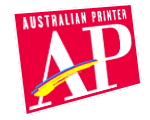At the Sydney dinner (l-r): Mark Holland, technical manager and Greg Street, general manager, Spicers Paper; Alessandro Pico, Export Department area manager and Marco Chiodaroli, technical service, Cartiere Burgo spa
Spicers Paper general manager, Greg Street, hosted dinners with customers in Sydney and Melbourne this month celebrating more than 25 years of successful importing and use of Monza Recycled paper in Australia. Monza is manufactured by Cartiere Burgo of Italy, and the mill was represented at the dinners by Alessandro Picco and Marco Chiodaroli. Diners learned that Monza was the first recycled coated paper grade in Australia. According to Spicers, "Monza Recycled comes to us from the crafts-people at the Burgo mill in Italy. To the naked eye, there’s nothing recycled about it. It looks and performs like fresh, first generation stock. But therein lies the beauty. Monza Recycled is actually produced with 55 per cent recycled fibre (25 per cent post-consumer and 30 per cent pre-consumer, not including mill-broke) and 45 per cent oxygen bleached virgin pulp".
Among a host of environmentally friendly qualities, the paper’s 45 per cent virgin pulp is totally derived from sustainable forest regions. The bleaching processes employed in its manufacture do not use elemental chlorine and the stock contains a significant level of recycled material. Cartiere Burgo has achieved ISO14001 accreditation for adhering to stringent international standards and this is set to ensure continuous reduction of environmental impact.
A major industrial group, Cartiere Burgo specialises in the production of graphic papers (mostly coated) with more than 6000 employees and an annual turnover in excess of 2.0 billion euro. Every year, its 15 mills produce more than 2.5 m tonnes of paper, of which more than 80 per cent is made up of coated woodfree papers (CWF) and coated mechanical papers (LWC + MWC) used to print catalogues, magazines, commercial matter and books.
In recent years, Cartiere Burgo has carried out extensive rationalisation of his productive activities, resulting in increased production capacity, shorter lead-times for orders, more immediate response to market developments and constant product quality.






